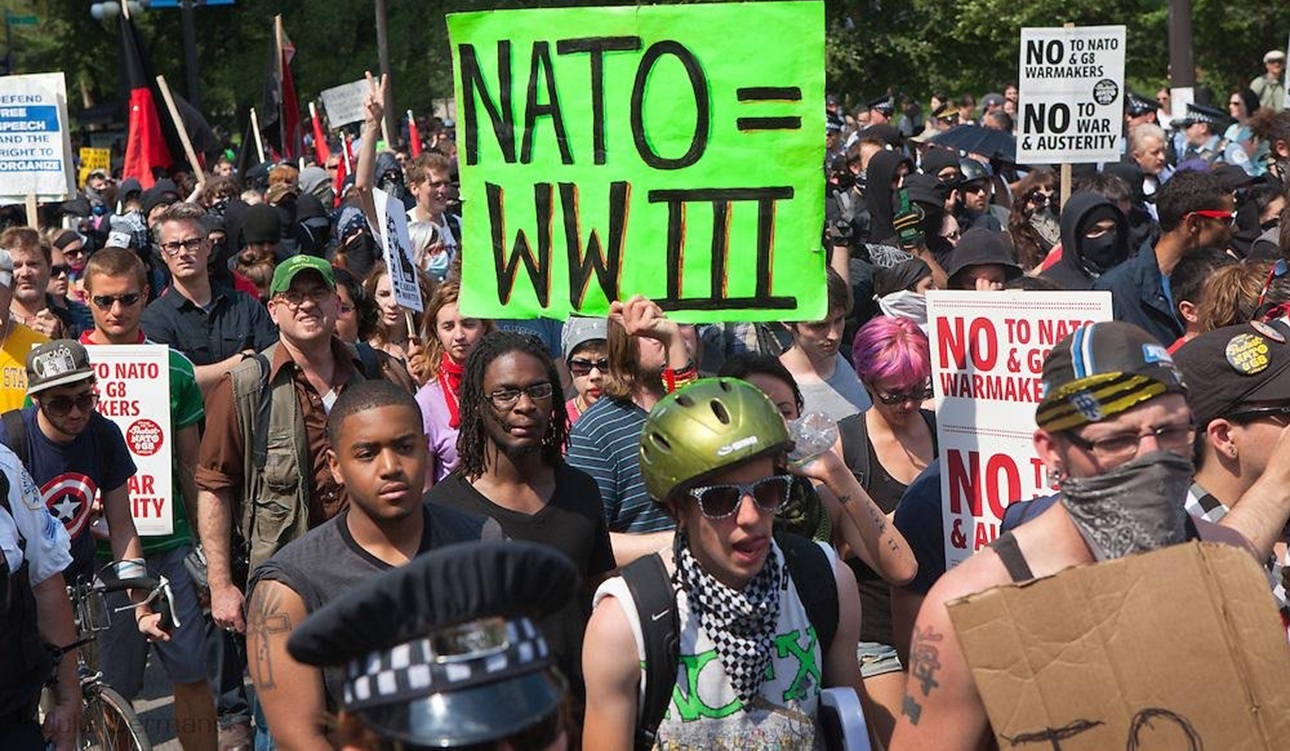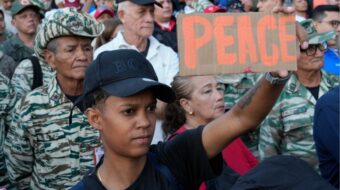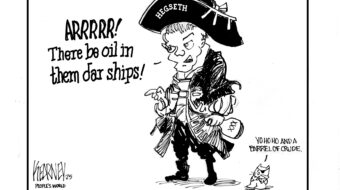
Following is the article People’s World ran yesterday on the NATO war summit in the nation’s capital.
As predicted in the article, NATO ministers are already appearing on cable TV and other outlets, calling for procurement of all kinds of new weapons aimed at achieving U.S. and NATO supremacy around the world. This morning the Prime Minister of Denmark noted that NATO has to stop talking about Russia’s war in Ukraine and instead realize that it has to step up its fight against what she called Russia’s “war on the entire world order.” Peace talks of any kind are obviously not on the minds of the NATO war ministers.
It is clear that NATO, led by the U.S., intends to live up to its growing reputation as the most dangerous military alliance in the world. Millions have died as a result of NATO policy since it was founded 75 years ago.
Protests have and are breaking out in the U.S. and around the world against the war summit opening today in Washington.
Flying under the news radar this week is the fact that President Joe Biden is leading, starting Wednesday, a meeting of NATO chieftains in Washington who are planning to ramp up by many tens of billions of dollars how much they will spend annually on war and destruction around the world.
People took to the streets this weekend in protest against a military alliance led by the U.S. that is expected to map plans to continue the disastrous war in Ukraine until Russia is defeated and weakened. Despite strong pressure even from inside that country, NATO is telling Ukraine not to negotiate because the military alliance aims to keep Russia in war for the foreseeable future.
The demonstrations in Washington opposing the war summit, particularly its plans for Ukraine, reflect U.S. public opinion on the Ukraine war and many other issues. A recent Economist poll showed Americans supporting negotiations to end the Ukraine war by a 68–8-point margin.
The protests in D.C. started with day-long teach-ins at a church on July 6. On July 7, demonstrators were out in force, descending on the White House to protest the NATO gathering, which was called ostensibly to “celebrate” the alliance’s 75th anniversary. NATO was designed to cut socialist countries out of the post-war construction of a peaceful non-aligned Europe and to instead impose U.S. military control over as much of the continent as possible to counter the Soviet Union, which had been a crucial factor in the world democratic victory over fascism.
The socialist countries formed the Warsaw Pact in response, but that alliance dissolved at the end of the Cold War. Rather than likewise dissolving itself, NATO instead armed itself to the teeth with all the latest high-tech weapons, including nuclear ones, and expanded eastward to swallow up what had been the Warsaw Pact countries. Led by the U.S., and contrary to promises made at the end of the Cold War, NATO expanded right up to the borders of Russia. This was a major contributing factor to the war in Ukraine since Russia would not accept a NATO presence in that country along with its presence along its borders elsewhere.
The NATO leaders this week plan to ratify a host of Biden-proposed policies, including pumping more money into modernizing nuclear weapons, reaffirming sending billions of dollars of military aid every year to Ukraine, and official NATO silence on the Israeli war against Palestinians in Gaza and elsewhere. Some countries are expected to break with that last aim, specifically Germany, regarding the ongoing genocide in Gaza.
“NATO represents U.S. militarism,” said one rally speaker, Ann Wright, a member of CodePink and an ex-U.S. Army colonel who resigned her position in opposition to the invasion of Iraq. “In order to fight those interests, we have to get at the root of those interests: War. To end war, we need to end capitalism and imperialism,” she declared. If ending it mandates tactics up to and including strikes, do it, Wright added.
Chants included “Down with NATO,” repeated many times, “Resistance is justified; Our people are occupied” referring to the Israeli reign over the West Bank and its war on Gaza, and “No troops on the ground; no bombs from the air. U.S. pullout everywhere.”
A German parliamentarian listed “three big lies” about NATO: That it’s a defensive alliance, that it stands for democracy, and that “it stands for human rights.” Others noted the real beneficiaries of militarism, including the Pentagon and U.S. defense contractors. Congressional testimony claims approximately 80% of U.S. military aid abroad is actually spent on weapons contracts with the military-industrial complex at home.
“For many of our members, this is deeply personal,” explained Joshua Shurley, national vice president of Veterans for Peace. “We were the stormtroopers for the American empire.”
Other speakers pointed out NATO had to find another reason to exist when its “enemy,” the former Soviet Union, dissolved in 1991. It’s now chosen as enemies both Russia and China and has ringed the two with carrier task forces, bases, and military aid to surrounding countries and territories, including Korea, Japan, the Philippines, and Taiwan. “NATO threatens the peace of the entire planet,” Shurley said.
Other causes added
Many protesters added other causes affected by U.S. imperialism and war, including repression of Hawaiian natives and campaigns against the right-wing oligarchy that has run the Philippines for years. The nation is a former U.S. colony, resulting from the imperialist Spanish-American War, and ensuing protectorate. It still houses a large U.S. military presence, which is expanding under the umbrella of NATO.
Many protesters demanded an end to U.S. funding of the far-right Israeli Netanyahu government’s military, and fluttering Palestinian flags were plentiful among the crowd. In the U.S., a wide variety of groups, including many labor unions, have called for a ceasefire in Gaza. Many see the struggle for peace in the Middle East as closely connected to success in the fight to keep Trump out of the White House in November.
“The battle lines are clear. We’re fighting a fascist danger at home and a genocidal war abroad. And to defeat the danger at home, we’ve got to defeat the war abroad,” Joe Sims, co-chair of the Communist Party USA, said at the party’s national convention last month.
As for prolonging the war in Ukraine, the U.S., Germany, Poland, and other NATO nations, rather than urge for peace talks, plan to funnel more arms, ammo, tanks, drones, and planes to the country’s government. Biden said last week he’d send a small contingent of troops as “advisers,” to Ukraine to allegedly repair U.S.-supplied military equipment. Sending “advisers,” of course, was the first key step in the long and bloody U.S. war in Indochina. The New York Times already reported this week on the operation of a mercenary “American-led unit” that has been illegally executing Russian prisoners of war.
The crowd in D.C. responded enthusiastically to numerous speakers, including one who declared that since its founding in 1949, NATO has been responsible for wars that killed an estimated 4.5 million people—and that’s not counting Gaza, even though, as another speaker noted, the U.S. and Germany are Israel’s prime arms suppliers.
The conflicts speakers laid at NATO’s feet stretch back to the 1950 Korean War, although in that conflict, the U.S. controlled and enlisted the United Nations. The NATO-generated conflicts do not include the U.S.’s 64-year blockade of Cuba. One group of marchers advocated lifting that, too. They also do not include the U.S.-backed coups in Latin America and the Caribbean or the CIA-sponsored overthrow of Mohammed Mossadegh in Iran in 1953, with British aid.
But Biden’s aid to the Israeli military was a particular target, along with the NATO alliance.
They blame Biden
The protesters blame Biden for keeping military aid going to Israel, while not using U.S. leverage to yank that aid to force Netanyahu into accepting a ceasefire and negotiations.
Medea Benjamin, co-founder and leader of Code Pink, touched on NATO’s internal politics. “The (Ukrainian) war gave NATO a new lease on life,” she declared, after its original reason for existence, to contain and/or combat the USSR, vanished when the Soviet Union folded. Benjamin also faulted the war for forcing NATO nations to spend at least 2% of their gross domestic product on their militaries. That’s where Trump again enters the picture. In his time in the White House, Trump demanded—and got—the other NATO nations to meet that goal or face a U.S. abrogation of NATO’s “mutual defense” treaty clause and end of funding.
With the largest gross domestic product among NATO members, the U.S. pays for more than half of NATO and runs it for all practical purposes. After Trump’s demand and threat, most other NATO nations successfully scrambled to meet that spending target.
That money “comes from us and from the safety net that is now in tatters in many European countries,” Benjamin said. Those tatters include the underfunding of Britain’s National Health Service by the U.K.’s now-toppled Tory government and French President Emmanuel Macron’s demands to raise the retirement age and cut pensions.
Some NATO countries initially had to be dragged by the Biden administration into backing the war against Russia in Ukraine. Germany, for example, had a lucrative economic deal with Russia whereby it got low cost energy via pipelines linking the two countries. Biden has boasted about “taking care” of those pipelines. Those that crossed Ukrainian territory were disabled after the Russian invasion, while those crossing under the Baltic Sea were mysteriously blown up, forcing Germany to purchase energy from U.S fossil fuel companies instead of Russia.
The Germans, who will parrot U.S. policies at the summit this week, are still acting as if they are clueless about who blew up their NordStream pipelines.
The war plans expected to be laid out this week were actually developed by NATO leaders in Prague in May.

Among those plans are ones that involve joining Biden in his new Cold War against China. They will openly accuse China of supplying weapons and high tech to Russia for its war in Ukraine and for its long-term resistance to U.S. and NATO sanctions.
They will also announce the building of a “drone wall” in the Baltics and an expensive “integrated air defense system” across Europe.
The main feature of the summit, however, will be an attempt to show “unity” behind the idea that through Ukraine, NATO can defeat Russia and that any support for negotiations to end that war amounts to total surrender to Putin.
Many countries have pointed out at the U.N. that Biden and NATO rejection of negotiation and diplomacy in favor of a long war that will eventually “weaken” Russia is a flagrant violation of the “Pacific Settlement of Disputes” that all U.N. members are legally committed to under Chapter VI of the organization’s charter. As it says in Article 33(1):
“The parties to any dispute, the continuance of which is likely to endanger the maintenance of international peace and security, shall, first of all, seek a solution by negotiation, inquiry, mediation, conciliation, arbitration, judicial settlement, resort to regional agencies or arrangements, or other peaceful means of their own choice.”
NATO leaders are also expected to set up a new permanent war headquarters, so to speak, at the U.S. military base in Wiesbaden, Germany, hiring 700 or more to staff it.
In a recent article published in numerous publications, Medea Benjamin noted that NATO leaders are planning to commit to providing Ukraine with $43 billion worth of equipment each year, indefinitely. The article notes that the policy echoes George Orwell’s “War is Peace” slogan in his novel, 1984. The idea NATO has is that the longer it commits to war, the sooner Ukraine will have peace.
The summit will also discuss how to bring Ukraine closer to NATO membership, a specific move that guarantees the war will continue since Ukrainian neutrality is Russia’s principal war aim.
Ian Davis of NATO Watch reported NATO’s rhetoric echoes the same lines he heard throughout 20 years of war in Afghanistan: “The Taliban (now Russia) can’t wait us out. But the vague hope that the other side will eventually give up is not a strategy.” When the U.S. and NATO finally admitted defeat in Afghanistan, after their failed policy of destroying socialism in that country by backing reactionary forces, it was the Afghans who had paid in blood for the U.S. and NATO policy.
By refusing to support Ukraine when it was talking peace at the negotiating table in April 2022, and instead demanding Ukraine accept NATO’s definition of “victory,” the U.S. and Britain escalated the war with disastrous results for Ukraine. Russia’s invasion and NATO’s pressure on Ukraine not to negotiate created the situation of a protracted, potentially nuclear, war between the U.S. and Russia. Turkish leaders and diplomats complained at the time about their NATO allies, the U.S. and Britain, sabotaging their peacemaking, while France, Italy, and Germany resisted the U.S. for a while but soon surrendered to the Biden-led war camp.
In a perfect world, NATO could actually become a force for peace if it would decide this week that in a year, it will follow the example of the Warsaw Pact in 1991 – that is dissolve itself entirely, ending what has become the most dangerous military alliance in the world. If Biden pushed for that, he would prove to the world that he is reversing the lapse of judgment he suffered when he first decided strengthening the world’s most dangerous military alliance was more important than peace.
We hope you appreciated this article. At People’s World, we believe news and information should be free and accessible to all, but we need your help. Our journalism is free of corporate influence and paywalls because we are totally reader-supported. Only you, our readers and supporters, make this possible. If you enjoy reading People’s World and the stories we bring you, please support our work by donating or becoming a monthly sustainer today. Thank you!











